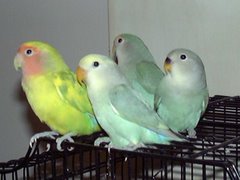Sexing Lovebirds- a Herculean task?
Lovebirds are a group of miniature parrots with short square tails. Their main cloring is green with some orange and yellow feathers in the tail. The head coloring varies with the species of which there are quite a few. Sexing the lovebirds is difficult for aviculturist. Here are the few tips to perform the sexing the lovebirds without undue stress to the birds--
Few tips for sexing your lovebirds
1. Pelvic area is wider in breeding hens than in cocks
2. Spread between feet of hen when perching is up to 1 cm greater than that of cock.
3. Hen only carries nesting materials.
4. Total lack of breeding activities indicates keeping of same sex birds.
5. Usually females are heavier and sturdier in build.
6. Intense coloring is observed among males. (In animals/birds, male are usually pretty)
7. Female birds always bite vigorously than males.
Confirmed method of sexing lovebirds
Although no traditional method is available for sexing a lovebird, DNA sexing is the perfect method to get 100 percent accuracy.
Few tips for sexing your lovebirds
1. Pelvic area is wider in breeding hens than in cocks
2. Spread between feet of hen when perching is up to 1 cm greater than that of cock.
3. Hen only carries nesting materials.
4. Total lack of breeding activities indicates keeping of same sex birds.
5. Usually females are heavier and sturdier in build.
6. Intense coloring is observed among males. (In animals/birds, male are usually pretty)
7. Female birds always bite vigorously than males.
Confirmed method of sexing lovebirds
Although no traditional method is available for sexing a lovebird, DNA sexing is the perfect method to get 100 percent accuracy.







 Free Ads For Bloggers
Free Ads For Bloggers


No comments:
Post a Comment